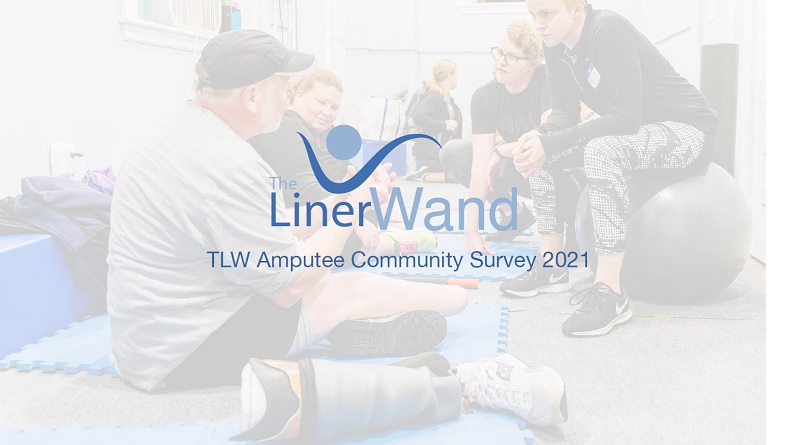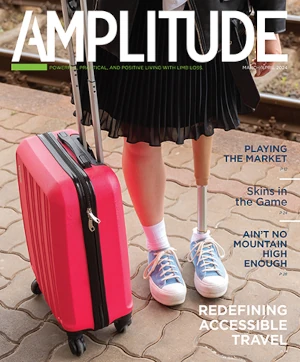As we’ve noted before, there aren’t any authoritative sources of top-line data about the US amputee population. That’s supposed to change soon, once the Limb Loss and Prevervation Registry gets up and running. In the interim, we’ll whet our appetite with the Liner Wand’s Amputee Community Survey, which came out earlier this month. Conducted between February 1 and March 15 of this year, the survey drew 336 responses to questions involving mental health, physical fitness, prosthesis satisfaction, and overall quality of life.
Before we get to the findings, an important caveat is in order. The people who responded to the Liner Wand survey differ significantly from the best estimates of the US amputee population’s demographic profile, which are largely based on a 2008 study published in the Archives of Physical Medicine and Rehabilitation. The APMR research isn’t perfect, as it’s 13 years old and is based on an incomplete data set. Even so, the APMR study examined a much larger population (more than 1 million people) than the Liner Wand survey, and therefore it’s presumed to be a more accurate reading of the community’s overall demographics.
The Liner Wand’s survey has the advantages of being much more current, and it addresses quality-of-life issues that went way beyond the scope of the APMR study. For those reasons, it’s a very useful resource; it’s simply important to keep the demographic factors in mind when interpreting the data. The Liner Wand’s survey population departs from the APMR’s amputee population in two major respects:
It’s a much younger cohort. APMR estimated that 18 percent of amputees are age 44 or younger, while more than 70 percent of the Liner Wand’s respondents were age 50 or below. At the other end of the spectrum, APMR found that just under half (44 percent) of US amputees are older than 65. In the Liner Wand’s survey, only about 20 percent fell into that age range.
It contains far fewer vascular patients. The APMR estimated that 54 percent of amputations are caused by diabetes and peripheral artery disease. Trauma accounted for most of the remainder, with cancer and other causes making up single-digit percentages. However, only 13 percent of the Liner Wand’s respondents cited diabetes as a cause, while nearly 60 percent cited trauma. Moreover, about 1/8 of the Liner Wand’s population identified themselves as congenital amputees, a category the APMR study didn’t even consider.
In short, the Liner Wand’s respondents are disproportionately young and healthy, compared to the average amputee. Keeping these caveats in mind, here are some interesting takeaways from the survey.
Nearly three-fourths of amputees wrestle with mental health issues.
In response to the question “Do you still experience issues with your emotional health because of your amputation?”, 22 percent answered “Often” and 50.9 percent answered “Sometimes.” We should note that this survey skews heavily toward recent amputees; nearly half of the respondents (41 percent) lost their limb within the last three years and are still in relatively early phases of adjustment.
A couple of related questions add some contours to the mental-health picture. One-third of the respondents expressed anxiety about their future, and almost 80 percent believe the prosthetics industry can do more to support amputees’ mental health.
More than half aren’t connected with a support group, but wish they were.
This seems related to the mental-health question, no? Only 19 percent of the respondents regularly attend a support group, while 28 percent expressed no interest in participating. Everyone else—51.5 percent—said they don’t regularly attend support-group meetings, but they wish they did.
One particularly interesting corollary to this question is that 70 percent of the respondents answered “yes” to the question “Do you have a strong support system?” In other words, a good chunk of the amputees in the survey feel well supported yet still wish they were more involved in a support group. Two-thirds of the respondents are employed or self-employed, and a similar percentage have a spouse or live-in partner; this group generally has a lot of emotional connection and social interaction. Nonetheless, their need to connect with other amputees is not being met.
Left unanswered are the reasons that people can’t (or choose not to) follow through on their interest. Amplitude often hears from readers who can’t attend support groups because they lack transportation, live too far from meeting location, or simply don’t know where to look for a group in their area. However, given the overall youth and fitness of the Liner Wand’s respondents, we suspect that non-participation is more often due to busy schedules—the cohort is mostly employed and mostly attached, leaving less time for a support group.
More than half aren’t active in organized adaptive sports or fitness programs, but would like to be.
Notice a pattern here? The survey respondents are quite active overall. One-fourth say they’re physically active for at least an hour a day, half get 30 to 60 minutes of activity a day, and 20 percent get that much activity several days a week. Only 6 percent describe themselves as not active.
Yet only 29 percent are connected to an organized sports or fitness program, whereas nearly twice that many—55 percent—are unaffiliated but would like to be affiliated. We suspect the same considerations apply here as in the case of amputee support groups, viz.: People would like to be more connected to other amputees, but they don’t follow through because life keeps getting in the way. However, there’s one other important consideration that applies to sports/fitness programs: Adaptive sports equipment can be expensive, and that’s a deal-breaker in many cases.
There’s a pending survey on this subject, co-sponsored by Move United and the University of Illinois. We’ll be interested to see how its findings line up with the Liner Wand’s survey.
Most amputees consider their pain levels tolerable.
More than half the Liner Wand respondents reported that pain related to limb loss typically fell at level 3 or lower on a scale of 0 (lowest) to 10 (highest). Only 20 percent reported pain of 6 and up. But that’s not to say pain is a small consideration. On the contrary, 81 percent of the survey takers said residual limb pain had caused them to struggle with their job, housework, or other daily activities at least once in the last month. Almost half (49 percent) experience phantom pain, 46 percent report residual limb pain, and 30 percent report pain from compensatory behaviors. Blisters, infections, sores, calluses, and dry skin all plague between a quarter and third of the participants.
Just over half (54 percent) of the respondents take pain medication. The most popular alternative methods for pain mitigation include ice (39 percent), massage (38 percent), heat (20 percent), distraction (20 percent), compression (15 percent), and meditation (14 percent).
Our takeaway from this part of the survey is that amputees, as a group, are pretty stoic. Pain comes with the territory, it’s at least modestly disruptive for almost everyone, but people are generally (though not universally) able to adapt to it and live with it.
What’s your opinion?
We reached out to the Liner Wand to see if they’d share their own big takeaways from the survey. They haven’t gotten back to us yet, but we’re still hopeful. In the meantime, we’d love to hear your reactions to this survey. If you have any strong thoughts about it, ping us at editor@livingwithamplitude.com.




